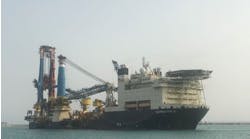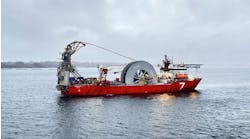Offshore staff
ZUG, Switzerland -- All three sections of the first Nord Stream 1,224-km (760-mi) gas pipeline in the Baltic Sea have been joined together using underwater hyperbaric tie-ins.
The completed pipeline will now be prepared ahead of connection later this summer to landfalls in Russia and Germany.
Hyperbaric tie-ins were performed at two locations. The connection of the Gulf of Finland and central sections took place offshore Finland in a water depth of 80 m (262 ft); linking of the central and southwestern sections was effected in 110 m (361 ft) of water off the Swedish island of Gotland.
Each tie-in was conducted in an underwater welding habitat and remotely controlled from the Technip DSVSkandi Arctic.
Nord Stream will eventually have two parallel pipelines, comprising 101,000 12-m (39-ft) long 48-in. (122-cm) diameter concrete-weight coated steel pipes, each weighing around 23 metric tons (25 tons).
The pipes for the first line were welded together on board specialist pipelay vessels and installed on the sea floor along a defined route passing through waters off Russia, Finland, Sweden, Denmark, and Germany.
Saipem'sCastoro Sei and Allseas' Solitaire are laying the second pipeline in the Gulf of Finland. Work here is progressing at the rate of roughly 6 km/d (3.7 mi/d), with more than 230 km (143 mi) installed to date.
When both lines are fully operational by the end of 2012, Nord Stream will have capacity to transport 55 bcm/yr (2 tcf/yr) of gas a year to mainland Europe.
06/21/2011


